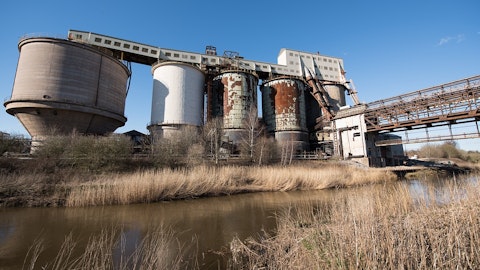Albert Chao: Yeah. That’s a good question. Yes, we are seeing more ideas — deals on banks, even though the deal flows have not really picked up, we’ve seen some industry announcements of people buying assets or companies in the HIP business. And suddenly, for Westlake, we’ll look at both sides, what makes the best economic return for Westlake through our synergies. So whether it’s in PEM side or HIP side, we constantly look at deals and on a global basis, not just in the US, and when you add economic value to us, we’ll take a hard look at those deals.
Matthew Blair: Sounds good. And then some of the consultants are showing PVC — global PVC capacity growth this year, around 3%. Does that match up with your expectations? And would you expect global PVC demand growth to be stronger than 3% this year?
Albert Chao: Yeah. I think we believe capacity additions is really not that great. People talk about China, especially with the carbide process being on the moratorium of new build and there’s some ethylene-based PVC plants starting in China, but the cost is a lot higher from either on produced ethylene or imported EDC. So I think global demand, that’s the key question. And some of this is political macroeconomic related. And the other one, interest rate related. So we are blessed that the US has, by far, the lowest cost position from low-cost ethane, ethylene and low-cost power to make chlor-alkali. So we’re able to export, as we mentioned in our talk earlier, they’re able to capture any opportunities that comes up for export. If the US demand is out there, or not enough. So that’s why we mentioned, in the fourth quarter, we did more export than second and third quarter, and we can still capture good cash contributions.
Matthew Blair: Great. Thank you.
Albert Chao: You’re welcome.
Operator: Thank you. One moment for our next question. And our next question comes from the line of Jeff Zekauskas from JPMorgan. Your question please.
Jeff Zekauskas: Thanks very much. Did epoxy profits meaningfully decrease sequentially?
Steve Bender: Yes. Jeff, it’s Steve. Yes. And when you think of the profit contributions, they were continuing to decline over the second half of 2023. So sequentially, from 3Q to 4Q, they certainly declined and they declined from 2Q into 3Q. So there was a sequential decline over the course of the second half of the year.
Jeff Zekauskas: Okay. And then in your earlier remarks, you highlighted the sequential decline in PEM as the result of lower caustic soda prices. So if that was the largest component, like order of magnitude, were they lower by $100 a ton in the quarter sequentially?
Albert Chao: Yes. I would think combination of caustic and as well as some PVC price drop. But you’re right, I think caustic — last year, they dropped materially over, I think, $300 for the whole year last year. Every month, it dropped except, I think, in January or February now, we are seeing the first price increase. I think looking at — according to CMA reported $5 a term price increase in February, and that’s the first time for 14 months, that caustic price has not dropped, actually went up.
Jeff Zekauskas: Okay. And then in Housing and Infrastructure Products year-over-year in the fourth quarter, was that $53 million increase really fittings and pipes related? Or was it related more to the other parts of the HIP’s business?
Steve Bender: Yes. So Jeff, the contribution from both the pipe and fittings business and, frankly, our siding and trim business were strong in that period. So it’s both pipe and fittings and siding and trim business.
Jeff Zekauskas: And then lastly, you talked about raw material cost inflation in HIPs. I don’t think there’s any raw material cost inflation in PVC. So where is the raw material cost inflation coming from in HIPs for 2024?
Steve Bender: Yeah. So Jeff, I’m speaking to the PVC price nominations that we see that are out in February by all the producers at this stage. So Westlake and all the others have price nominations out for February. And so certainly, as we look forward, given the volume demand we’re seeing in our downstream building products businesses. And we mentioned the strength that we’re seeing as we exited 2023 into ’24 in the building products side of our business, seen the pull on those products, which should pull on the PVC resin. And this is why we’re seeing that pull and why we’ve seen price nominations by all the producers in the marketplace.
Jeff Zekauskas: But you’re — so what you’re saying is that the margins because you transfer at market from PEM, the margins in HIPs will be pushed down and the margins in PEM will be pushed up, all things being equal. Is that right?
Steve Bender: Correct.
Jeff Zekauskas: Yeah. Thank you very much.
Steve Bender: You’re welcome.
Operator: And our next question comes from the line of Richard [indiscernible] from Wells Fargo. Your question, please.
Unidentified Analyst: Great. Thanks for taking the question. First, on the HIP segment. Just wondering about the competitive landscape, the 11% year-over-year volume growth. Does that reflect any market share gains within the product lines? And where are you seeing the strongest increase in prices?
Steve Bender: So we’ve seen some good traction really with our customer base. You’ve seen us make many references to the portfolio and the brands that are associated with that portfolio. And so having a nationwide footprint and a broad and strong product offering allowed us to really make good contributions in market share gains and certainly building relationships with many of these distributors who are servicing many of the nationwide homebuilders is really where we’re seeing good traction.
Unidentified Analyst: Okay. Great. And then on the pricing side, are you seeing a more competitive pricing landscape? Or is that just pricing pressure, given lower housing starts and the weaker macro outlook year-over-year?
Steve Bender: I would say, we’ve been able to really maintain, and you saw this in the fourth quarter relative to the third quarter, pricing was relatively flat in HIP. And so I would say that we were able to maintain pricing in — sequentially from 3Q to 4Q, as we pull into the first quarter of ’24, continuing to see good volume and certainly trying to then be the beneficiary of that volume pull, my guidance, and we’ve talked about this in a couple of the other questions, that we do have some price nominations out for PVC resin. And so certainly, if we see strength in PVC demand-related products, siding, trim, shutters and other applications, we will certainly try to not pass those higher prices, certainly try to pass those higher prices through and not get caught in a margin compression, but we’ll see how the market demand-wise plays through.
Steve Bender: Great. Thank you.
Operator: Thank you. One moment for our next question. And our next question comes from the line of Vincent Andrews from Morgan Stanley. Your question please.
Turner Hinrichs: This is Turner Hinrichs on for Vincent. I’m wondering if you could provide an update on what you’re seeing for inventory levels among customers and where you’re expecting tailwinds from restocking mentioned in your prepared remarks?
Albert Chao: Yes. Talking about PEM customers or HIP customers?
Turner Hinrichs: In particular, the — whichever channels we’re seeing the restocking mentioned, but PEM would be of interest in particular.
Albert Chao: Yeah. I think as you can tell, when prices come — came down and demand came down last year, customers tend to be — have low inventory levels and they order — only order when they need products. And so over year-end, also they don’t need to carry inventories. So as we come into January, February of this year, customers are starting to order to their demand. And so we are seeing the order going up. But I think inventory is still — customer is very cautious they are still keeping relatively low to medium levels of inventory. And that’s true also for the HIP side. And — but as you know, this is the good material construction starting — usually starting from March is the season people start increasing construction.
And with the warmer weather, people stopped it earlier. So I think they are just ordering to meet the demand, make sure they have good — they have the products because if you miss one item, the house is not complete. So they want to make sure they have all the items delivered to the site, that they he can put a house together relatively quickly.
Turner Hinrichs: Great. Thanks for all the detail there.
Albert Chao: You’re welcome
Turner Hinrichs: I’m also wondering you do provide a little additional color on your outlook for the caustic soda industry and prices during 2024? I was wondering specifically also whether or what you’re expecting in the first quarter in terms of price and volume, and whether the increase you saw in caustic soda prices was driven by trade and freight dynamics from your perspective or underlying supply and demand?
Albert Chao: Yes. I think supply-demand has improved. I think we see some pulp and paper plants are running harder and they’re ordering caustic and chlorine. Now, as I mentioned earlier, the CMA’s forecast for operating rates for chlor-alkali in the US are running in the high 70s, which is okay, but not great. So this is their forecast now, things could change. But I think also, export prices started moving up. And again, the consultants, CMA looking at $5 increase in February and April is $10 and May is $5. Now, the industry that we have announced the price increase and other companies announced pricing increase more than what CMA has announced. And time will tell how much of our industry announcement will get put in place, but it’s a substantially higher price increase announced by the industry.
Turner Hinrichs: Okay. Great. Thank you.
Albert Chao: You’re welcome.
Operator: Thank you. One moment for our next question. And our next question comes from the line of Kevin McCarthy from Vertical Research Partners. Your question please.
Kevin McCarthy: Yes, thank you and good morning. With regard to your PVC production in 2023, I was wondering if you might be willing to split it into three buckets? Those would be the amount or percentage that you used internally in HIP versus US domestic sales versus export sales. How would you size each of those?
Steve Bender: Yeah, Kevin, it’s Steve. Because we’re using a lot of that PVC resin really in our Building Products business, roughly a quarter of it is going into the building products business into the HIP business, and the remaining 75% of that is sold either domestic or international, because we are selling so much of that 25% domestically, our mix relative to industries, therefore, is going to be a lower mix of exports relative to the industry average. So obviously, to the extent that we see the strong markets, domestically, we’d rather sell it domestically versus export. And that really — that percentage is always going to be lower than industry average because of that domestic — that internal sale. But I would say we certainly focus on the domestic market as much as we can and pivot to the export markets when there’s seasonal elements at play such as in the fourth quarter those exports tend to be higher.
And certainly, it’s also a function of how strong the domestic market is. So it’s hard to give you a hard and fast percentage of domestic or export per se.
Kevin McCarthy: Understood. That’s helpful. And then just coming back to the caustic soda discussion. Would you expect your average selling prices in the first quarter relative to the fourth quarter of 2023 to be higher or lower or roughly the same?
Steve Bender: You were asking about the average selling price for caustic in the first quarter versus the fourth quarter of 2023?
Kevin McCarthy: Yeah, that’s correct. 1Q is obviously more than halfway done. So just kind of curious if you look at your books for the next six weeks or so, you referenced some of the uptick in caustic prices in February. So one could argue, perhaps we’re coming off the bottom a little bit. But if I just think about that sequential move from 4Q into 1Q, do you think the result might be materially different in terms of your realized price for caustic?
Albert Chao: Well, the — according to CMA, fourth quarter last year 2023, caustic price domestically dropped by $60 a ton. And I said earlier, CMA looking at $5 increase in February and then $10 in April. So…
Steve Bender: So the average price will be lower in 1Q. I just want to make sure you were talking about 4Q versus 1Q ’24. Clearly, with the decline in price we’ve seen through ’23, the average price in ’24 will be lower than the fourth quarter average price in ’23.
Kevin McCarthy: Got it. Okay. Thank you very much.
Albert Chao: You’re welcome.
Operator: Thank you. One moment for our next question. And our next question comes from the line of David Begleiter from Deutsche Bank. Your question please.
David Begleiter: Thank you. Albert, how do you expect ethylene chain margins to progress through 2024?
Albert Chao: That’s a good question. As I said earlier, there are price increase, we have $0.05 a ton price increase achieved in January, and there are price increase announced for February, and one industry participant announced the price increase for March. And so we are seeing some improvements in export price. So we believe that some part of the price increase will go through, but in the first quarter, a lot depending on global economy, supply demand, macroeconomics and also the Red Sea, Suez Canal issues and Panama Canal, when will it be settled or subside issues. So all these have to come into play in terms of our pricing and volumes moving international trade. As you know, in polyethylene, the US exports a large quantity, I think close to about 50% plus or minus of total USP produced is exported.
So export is a big component of it. So all these dynamics is difficult to forecast what would happen. But we believe, at least domestically, in the first quarter, things should be better. And we mentioned earlier, that with lower price of natural gas and ethane, the ethane-based production costs should be low if you have polyethylene price increase, the margin should improve.
David Begleiter: Got it. And adjusting your cost savings in ’23 and ’24, how much will come from epoxy?
Albert Chao: Proxy is not a big part of the Westlake’s business. And we’re talking about — the problem was the Pernis, Netherlands plant epoxy that we have problems with. And you heard also, we are doing substantial cost reduction programs to make the system better and — but still Asian exports to Europe and is a big issue of keeping prices low. But epoxy as a whole is a small part of Westlake’s business.
David Begleiter: Thank you.
Steve Bender: And David, just maybe to give you a broader understanding of that savings over the course of ’24, I would guide to probably three quarters or so of that would probably be on the PEM side of the business and the other 25% probably be on the HIP side of the business. So you have an understanding of the relative expected mix of that savings of $125 million to $150 million that we expect to benefit from.
Operator: Thank you. One moment for our next question. And our next question comes from the line of Hassan Ahmed from Alembic Global Advisors. Your question please.
Hassan Ahmed: Good morning, Albert and Steve. A question around — good morning. A question around the chlor-alkali markets. Over the last couple of years, I mean, certainly since the end of 2020, the virtue of sort of the chlor-alkali story had been a high degree of discipline, particularly in the North American market, right? And obviously, that resulted in decent sort of pricing growth, margin growth and the like. And then obviously, we started seeing destocking over the course of the last couple of quarters, and some pricing and margin erosion, right? And we all talked about sort of operating rates in North America being relatively depressed, but demand beginning to pick up. Now, one of your larger competitors out there has been pretty vocal about potentially ramping up utilization rates February onwards.
So my question to you is, what gives you confidence that the industry will continue to remain disciplined, particularly keeping in mind operating rates, I think you alluded to them being around 70%, and you holding on to pricing or maybe even gaining some?
Albert Chao: Yeah. Very good question. And I think a big part was export price. When export prices was high, then the US enjoyed also high domestic price. But export price start to decline pretty sharply, 2023. And so US domestic market has to respond. And we are seeing signs that the export price stabilize and start moving up a little bit. So I think the economics have — whether it’s going to the alumina business or pulp and paper, as we said earlier, we see some sign of improvement and demands increasing international caustic market. There’s not a huge amount of capacity added globally. It’s really a demand issue, not a supply issue. And hopefully, as economics improves globally and also China’s economy improves, we are hearing that the government in China is trying to, again, stimulate its construction business after the New Year’s over, only time will tell what kind of initiatives they will have.
If the global economy stabilizes and continue to recover and grow and lower interest rate, it will help caustic — caustic is such a broad industrial chemical, it’s used — it goes into many, many segments of our economy, consumer, industrial, investment, all that. So it’s a bellwether of the global economy. And we hope this year, things will bottom out, or last year, bottom out and getting better. So we are optimally cautiously optimistic on caustic market, but a lot of things could happen.
Hassan Ahmed: Fair enough. And as a follow-up on the PVC side of things, you touched on China earlier. I mean, let’s assume for a second that there is no stimulus in China. Obviously, barring that, I’d like to think that the Chinese market is quite long PVC. So what are you guys seeing in terms of trade flows out of China, on the PVC side in particular? And barring a stimulus, could that be a risk maybe potentially even to domestic US pricing if China ramps up exports?



